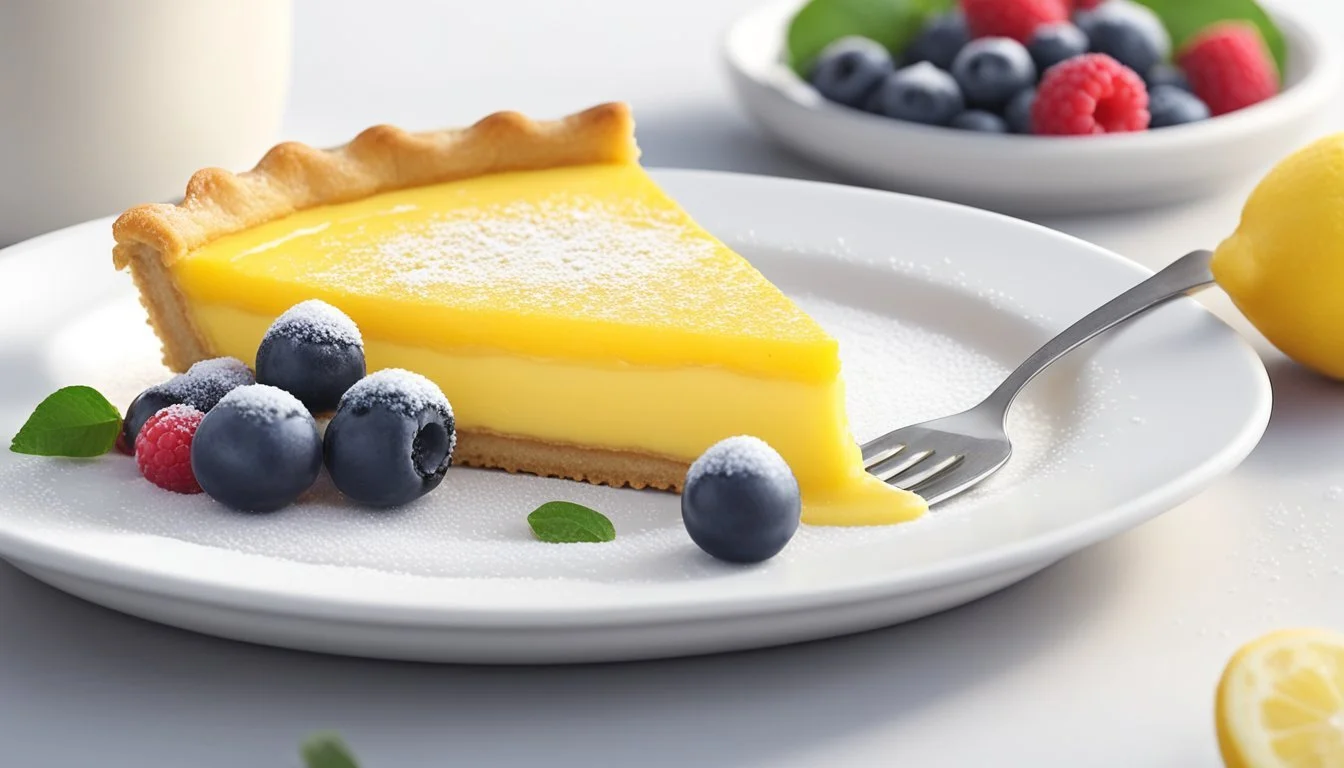Best Way to Reheat Lemon Curd Tart
Ensuring Creamy Texture and Zesty Flavor
Reheating a lemon curd tart so that its creamy texture and zesty flavor remain intact requires careful attention. This dessert embodies a harmony of bright lemon curd nestled in a crisp pastry. The key to preserving its character lies in a reheating method that avoids overexposure to heat, which can compromise the delicate balance of tartness and sweetness that defines a lemon curd tart.
A lemon curd tart is known for its smooth, velvety filling that delivers a punch of citrus flavor. Achieving an even temperature throughout the tart without melting the curd or allowing the pastry to become soggy is the challenge when warming this dessert. It's essential to employ a reheating technique that gently brings the tart to the desired warmth, ensuring the filling stays creamy and the pastry retains its bite.
The best way to reheat a lemon curd tart involves a low-temperature oven and patience. The process should be gradual and monitored closely, as the tart needs to warm through to the middle without the edges becoming too dry or the curd separating. This method upholds the textural contrast and bright, zesty flavor that make a lemon curd tart a delectable treat.
Understanding Lemon Curd Tarts
In exploring the complexities of lemon curd tarts, one must consider the delicate balance of ingredients that create its signature creamy texture and zesty flavor profile.
Ingredients and Their Roles
A lemon curd tart hinges on a harmony of ingredients that each play a pivotal role in the final result. The lemon curd is the star, with its bright, citrus essence derived from lemon juice and zest offering a sharp contrast to the sweetness and richness of the tart.
Butter: Provides a silky, melt-in-the-mouth feel and helps in binding the curd together.
Sugar: Balances the acidity of the lemons and adds to the curd's smoothness.
Lemon Juice: The source of the tart's characteristic zesty flavor.
Zest: Adds an intense citrus note that deepens the overall lemon flavor.
Eggs: They are essential for the structure, acting as a thickening agent to achieve the curd's creamy consistency.
The Importance of Texture
The texture of a lemon curd tart is as significant as its flavor. It should be smooth and creamy, characteristics that are largely attributed to the precise cooking technique and the emulsifying properties of the butter and eggs.
Smooth: A sign of a well-made curd, where ingredients are blended thoroughly.
Creamy: Indicative of the perfect ratio of butter and eggs, providing a rich mouthfeel without being too dense.
One should note that the texture is also impacted by the tart's crust, which should be crisp and crumbly, forming the ideal foundation for the lemon curd filling.
Preparing Your Tart for Reheating
Ensuring your lemon curd tart retains its creamy texture and zesty flavor after reheating begins with proper preparation. The key steps involve handling the tart shell with care and storing the lemon curd filling appropriately.
Handling the Tart Shell
Before reheating, it's crucial that the tart shell has been stored in a way that preserves its crispness. The tart shell should be allowed to cool completely at room temperature; then, it should be wrapped tightly with plastic wrap. One can store the wrapped tart shell in the refrigerator if it will be reheated within a couple of days. This method prevents moisture accumulation, which can lead to a soggy crust.
Storing Lemon Curd Filling
For the lemon curd filling, its storage is as important as its preparation:
Temperature: Keep the filling in the refrigerator to maintain its freshness and prevent spoilage.
Container: Store the lemon curd in an airtight container, minimizing exposure to air to preserve its creamy consistency.
Separation: If the tart shell and the lemon curd filling are stored separately, it allows for the filling to be reheated gently and poured into the shell, ensuring an even warmth throughout the tart.
By following these methods, one ensures that the tart's components are optimally preserved for reheating, leading to a dessert that is as delightful as when it was first baked.
Reheating Techniques
When reheating a lemon curd tart, one must maintain a gentle heat to preserve the delicate texture of the filling. Using the correct method is key to achieving that creamy consistency without compromising the zestiness of the lemon.
Oven Method
To reheat in the oven, preheat it to a low temperature, around 325°F (163°C). Place the lemon curd tart on a baking sheet and heat for about 10 minutes. This method is ideal for ensuring an even warmth that doesn't alter the tart's smooth consistency.
Temperature: 325°F (163°C)
Time: Approx. 10 minutes
Microwave Method
The microwave should be a last resort due to its uneven heating which can quickly ruin the tart's texture. If necessary, use a low power setting and short bursts of 10-15 seconds, checking the tart's warmth between intervals.
Power Setting: Low (20-30%)
Time: 10-15 second bursts
Stovetop Method
This method isn't commonly recommended for reheating baked desserts like lemon curd tart. However, one could reheat individual servings of the lemon filling over a double boiler on low heat if the filling is separated from the crust.
Heat: Low
Setup: Double boiler
Note: Only for filling, not the entire tart
Tips for Preserving Quality
When reheating a lemon tart, the goal is to maintain its creamy filling and flaky crust. The right way to apply heat prevents a textural compromise, particularly crucial to citrus-based desserts like the lemon tart.
Managing Heat Distribution
Heat must be distributed evenly to avoid overheating any section of the lemon tart. It is advised to heat the tart in an oven preheated to a moderate temperature, usually around 350°F (175°C). This ensures that both the curd filling and the pastry receive a gentle and consistent amount of warmth. The tart should be placed on a middle rack to avoid direct heat from the top or bottom elements which could result in uneven cooking.
Avoiding Sogginess
The key to preserving the crust's texture is preventing moisture from making it soggy. This can be achieved by placing the tart on a baking sheet and covering it loosely with aluminum foil to protect the surface. To further reduce steam accumulation, one can pierce small holes in the foil. For a crispier crust, a short period of heating without the foil at the end of the reheating process is effective.
Utilizing Double Boiler Technique
A double boiler technique is highly effective for reheating the lemon curd in a saucepan, especially when not reheating the whole tart. Fill a saucepan with a small amount of water and place it on the stove. Then, put the lemon curd into a heatproof bowl that fits onto the saucepan without touching the water beneath. Stir constantly as it heats to avoid scrambling the eggs in the curd and to ensure the lemon tart filling remains smooth. The gently simmering water will provide indirect heat, thus minimizing the risk of overheating the curd.
Garnishing and Presentation
The correct garnishing elevates the aesthetics and taste of a lemon curd tart. For the best results, one should consider the interplay of color, texture, and flavor that garnishes like fresh berries and whipped cream bring to the dessert. Now, let's take a look at specific garnishing and presentation techniques.
Adding Fresh Berries
A handful of fresh berries complement the zesty lemon flavor. One can place raspberries, blueberries, or blackberries atop the tart. Arrange them symmetrically for a visually appealing effect. Before using, ensure the berries are dried completely to prevent moisture from affecting the texture of the tart.
Berries to consider:
Raspberries
Blueberries
Blackberries
Applying Whipped Cream
A dollop of whipped cream on the side adds a rich and smooth component, contrasting beautifully with the tart's citrus profile. For added flavor, one can fold a hint of lemon zest or a sprinkle of confectioner's sugar into the cream before piping or spooning it onto the plate.
Whipped Cream Tips:
Fold in lemon zest for extra zing
Sprinkle with sugar for a touch of sweetness
Final Touches
To complete the presentation, a light dusting of confectioner's sugar over the tart adds a subtle sweet note while enhancing its visual allure. A few thin strips of lemon zest can also be artfully arranged on top. These final touches should complement the filling and not overwhelm the inherent flavors of the lemon curd.
Final Touch Elements:
Confectioner's sugar
Strips of lemon zest
Safety and Food Science
When reheating a lemon curd tart, one must pay careful attention to food safety concerns and understand the fundamental science behind it to maintain the quality and safety of the dish.
Botulism Risk with Eggs
Lemon curd tarts contain eggs, which are rich in proteins and fats and can harbor bacteria like Clostridium botulinum if not handled properly. It is essential to ensure the tart reaches an internal temperature of 74°C (165°F) to reduce the risk of botulism. Refrigerating the tart promptly after cooking and before reheating also aids in preventing bacterial growth.
Understanding the Chemistry
The chemistry of reheating a lemon curd tart involves the delicate balance between the eggs' proteins and the tart's acidity. One should reheat the tart slowly and at a low-to-medium temperature to prevent the proteins in the eggs from denaturing, which can cause curdling. Moreover, the heat must be evenly distributed to preserve the tart's creamy texture and zesty flavor without degrading its structure or taste.
Serving and Enjoying
A well-reheated lemon curd tart offers a harmonious blend of textures and flavors at the ideal serving temperature. Careful pairing with complementary flavors enhances the overall dining experience.
Optimal Serving Temperature
The lemon curd tart should be served at a temperature that allows the filling to be creamy yet firm. Refrigerating the tart thoroughly ensures that it firms up, typically for several hours, ideally after an overnight chill. This serving temperature showcases the zestiness of the lemon flavor to its fullest, while maintaining the desired consistency and preventing the filling from becoming too runny.
Pairings and Complementary Flavors
The vibrant lemon flavor of the tart pairs well with a variety of flavors and textures:
Fresh Berries: Strawberries, blueberries, or raspberries add a refreshing and slightly sweet contrast.
Whipped Cream: A dollop adds richness and smooths the tart's citrus edge.
Mint or Basil: These herbs provide a fresh aromatic lift, enhancing the tart's zestiness.
For added texture, sprinkle finely grated lemon zest on top just before serving, which not only contributes to the aesthetic but also intensifies the lemon tart's characteristic flavor.
Nutritional Information
When considering the nutritional value of a lemon curd tart, it is important to account for both its energy contribution and the vitamins and minerals it provides. This section outlines the typical nutritional content of a standard serving of lemon curd tart.
Caloric and Macronutrient Breakdown
Nutrient Amount per Serving Calories 300-400 kcal Total Fat 15-20 g Saturated Fat 5-10 g Cholesterol 100-150 mg Sodium 150-300 mg Total Carbohydrates 30-50 g Dietary Fiber 0-2 g Sugars 20-30 g Protein 4-6 g
The lemon curd tart is predominantly composed of carbohydrates, largely from the sugar and the pastry, while also delivering fat content from butter and eggs. This dessert can be high in saturated fat and cholesterol due to these ingredients.
Vitamins and Minerals Content
Lemon curd tart provides certain vitamins and minerals, although it should not be considered a significant source of daily nutritional requirements.
Vitamin C: As lemons are a key ingredient, the tart can have a moderate amount of Vitamin C, ranging from 10-20% of the recommended daily intake.
Calcium: From the butter and eggs in the tart, a small percentage of daily calcium needs can be met.
Iron: Present in small amounts, which comes from the eggs and enriched flour typically used in the pastry.
Potassium: Available in modest quantities due to the lemon content.
It should be noted that these values can vary depending on recipe modifications and serving sizes. Lemon curd tart is best enjoyed as a treat rather than a regular part of a diet focused on nutritional goals.
Storage and Shelf Life
Proper storage techniques are essential for maintaining the quality of a lemon curd tart. The tart's shelf life depends on whether it is refrigerated or frozen, both of which can preserve its creamy and zesty filling effectively.
Refrigeration Guidelines
Duration: Homemade lemon curd tarts should be consumed within 3-4 days when refrigerated.
Container: Store in an airtight container to prevent it from absorbing other flavors and odors.
Temperature: Keep the tart at a consistent refrigeration temperature of 40°F (4°C) or below to ensure food safety.
Freezing for Long-Term Keeping
Duration: Lemon curd tarts can be frozen for up to 1 month to maintain their best quality.
Packaging: Wrap the tart tightly in plastic wrap or aluminum foil, and place it in a freezer-safe container or a heavy-duty freezer bag.
Thawing: To use, thaw the tart in the refrigerator overnight. Do not thaw at room temperature, as it can affect the texture and flavor of the lemon curd filling.









